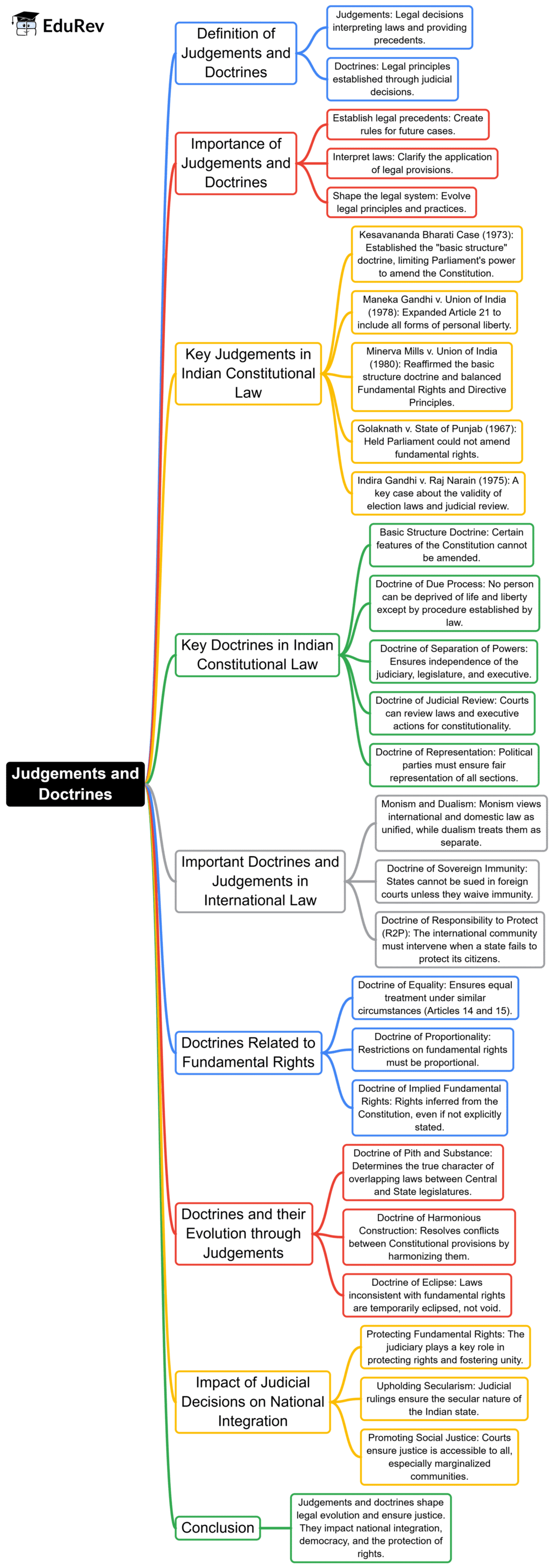UPSC Exam > UPSC Notes > Indian Polity for UPSC CSE > Mind Map: Judgements and Doctrines
Mind Map: Judgements and Doctrines | Indian Polity for UPSC CSE PDF Download

The document Mind Map: Judgements and Doctrines | Indian Polity for UPSC CSE is a part of the UPSC Course Indian Polity for UPSC CSE.
All you need of UPSC at this link: UPSC
|
142 videos|779 docs|202 tests
|
FAQs on Mind Map: Judgements and Doctrines - Indian Polity for UPSC CSE
| 1. What are the key principles behind judicial judgments in the context of Indian law? |  |
Ans. The key principles behind judicial judgments in Indian law include the doctrine of precedent, which mandates that lower courts follow the decisions of higher courts; the principle of natural justice, ensuring fairness in legal proceedings; and the interpretation of statutes, where judges ascertain the intention of the legislature while applying the law. Additionally, the balance between individual rights and public interest is crucial in judicial decision-making.
| 2. How do doctrines influence the interpretation of laws in India? |  |
Ans. Doctrines serve as guiding principles that help interpret laws. For instance, the doctrine of separation of powers delineates the functions of the executive, legislative, and judicial branches, preventing overreach. Other doctrines, such as the doctrine of proportionality, ensure that the actions of the state are reasonable and justifiable. These doctrines help maintain the rule of law and protect fundamental rights.
| 3. What role does precedent play in the Indian judicial system? |  |
Ans. Precedent, or stare decisis, plays a vital role in the Indian judicial system as it ensures consistency and predictability in legal rulings. Decisions made by the Supreme Court are binding on all lower courts, while High Court rulings are binding within their respective jurisdictions. This system helps to stabilize the law and allows individuals and entities to rely on established legal interpretations.
| 4. Can you explain the significance of landmark judgments in shaping legal doctrines? |  |
Ans. Landmark judgments are significant as they often set new legal precedents or reinterpret existing laws, thereby shaping legal doctrines. Such decisions can lead to significant changes in the legal landscape, influencing legislation and public policy. For example, cases addressing fundamental rights, such as privacy or equality, have prompted legislative reforms and have been instrumental in advancing social justice.
| 5. How do judicial doctrines evolve over time in the context of the Indian Constitution? |  |
Ans. Judicial doctrines evolve over time through the interpretation of constitutional provisions by the courts. The judiciary assesses societal changes, public policy needs, and evolving norms to adapt doctrines accordingly. For instance, the evolving interpretation of the Right to Life under Article 21 has expanded to include various rights, reflecting contemporary values and expectations of justice and dignity.
Related Searches





















